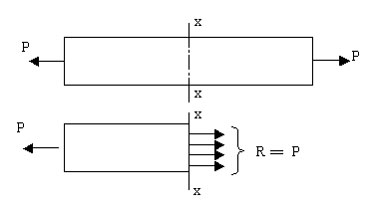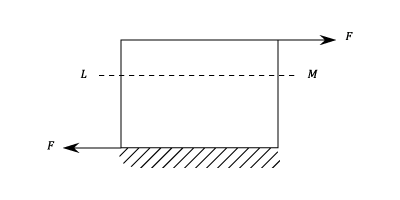20 Viva Questions on Stress and Strain
1. Define Load
Answer:
The external force acting on a body is called load
2. Define Stress.
Answer:
The internal resistance per unit area of cross-section by a body against the applied load is called stress.
3. Define Tensile Stress.
Answer:
When an axial push is applied on the cross-sectional area of a body, the stress induced is known as tensile stress.

4. Define shear stress.
Answer:
When two equal and opposite forces are applied tangentially to the cross section of a body, the stress induced is known as shear stress.

5. Define Strain.
Answer:
The ratio of change in dimension of the body to the original dimension of the body.

6. Define Elasticity.
Answer:
The property by virtue of which certain materials show elastic behavior (returns back to their original position after the removal of external forces) is called elasticity.
7. Define Compressive stress.
Answer:
When an axial push is applied to the cross sectional area of a body, the stress induced is known as compressive stress.

8. State Hooke’s law.
Answer:
This law states that when a material is loaded within elastic limit, the stress is directly proportional to the strain produced by the stress.
9. Define lateral strain.
Answer:
The ratio of axial deformation to the original length of the body is known as longitudinal strain or lateral strain.
10. Define Poisson’s Ratio
Answer:
The ratio of lateral strain to the longitudinal strain is known as Poisson’s ratio. It is denoted by ‘μ’ or 1/m.
11. Draw stress stain diagram.
Answer:
12. Define elastic limit.
Answer:
The value of stress corresponding to the limiting force upto which the material is perfectly elastic is known as elastic limit.
13. Define Yield point.
Answer:
The point in which the material yields and there is an appreciable strain without any increase in stress is called yield point.
14. What do you mean by plastic stage?
Answer:
If the material is loaded beyond elastic limit, then the material does not regain its original shape and size after the removal of load. Such a stage is known as plastic stage.
15. Differentiate between ultimate stress and breaking stress.
Answer:
When the stress attains its maximum value during loading of specimen, it is called ultimate stress. While the stress corresponding to the point at which the specimen breaks, is called breaking stress.
16. Define proof stress.
Answer:
Proof stress is the stress necessary to cause a permanent extension equal to a definite percentage of gauge length.
17. Define working stress.
Answer:
In the actual, the material is not subjected up to ultimate stress but only up to a fraction of ultimate stress. This stress is known as working stress. This stress is also known as allowable stress or permissible stress.
so Working Stress = (Ultimate Stress) / (Factor of Safety).
18. Define Factor of Safety.
Answer:
The ratio of ultimate stress and working stress is called Factor of Safety.
So, Factor of Safety = (Ultimate Stress) / (Working Stress)
19. State principle of superposition.
Answer:
This principle states that the resulting strain caused by a number of forces acting on its outer edges as well as at some other sections, along the length of the body, is equal to the algebraic sum of the deformation of the individual sections.
20. What is free body diagram.
Answer:
When a body is subjected to a number of tensile or compressive forces at different sections along the length of the body, the diagram of individual sections showing the forces is called free body diagram.

5 Responses to “20 Viva Questions on Stress and Strain”
NITISH KUMAR
Better
but here,you can see only basic question are present.
please incease it’s level .make question on detail study
of matterial.
admin
We will surely try.
Nanda
It is just a basic information please include more information
Aditi
Not as per Engineering standard!!
Gaurav Kumar
Corby’s experiment and viva questions of elasticity